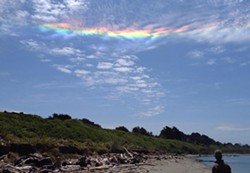[
{
"name": "Top Stories Video Pair",
"insertPoint": "7",
"component": "17087298",
"parentWrapperClass": "fdn-ads-inline-content-block",
"requiredCountToDisplay": "1"
}
]
I received a flurry of emails, complete with photos, following the Rio Dell-to-Trinidad appearance of a circumhorizontal arc on the afternoon of Day Two of the Kinetic Grand Championship (which is how we date things around here). Like the Holy Roman Empire (neither Holy, Roman, nor an Empire),the arc is neither circum-, nor arc-like (we'll get to the horizontal part in a moment), but the alternative fanciful name "fire rainbow" is even more confusing: no fire, not a rainbow.
In common with rainbows, these arcs are gorgeous, halo-like phenomena. But whereas rainbows result from sunlight passing through droplets of water comparatively low in the atmosphere, circumhorizontal arcs occur when sunlight is refracted by flat, hexagonal ice crystals found in cold cirrus clouds way up high, three or more miles overhead. Sunlight enters an ice crystal through a side face and exits through the bottom face, producing a red-to-blue spectrum, per the accompanying graphic kindly created by Field Notes predecessor Don Garlick (may his name be praised). Note that red is up, blue down, as in a primary rainbow. The spectrum results from the ice slowing -- and thus refracting -- blue, shorter-wavelength rays more than red ones. Just as Isaac Newton surmised, over 300 years ago.
For a circumhorizontal arc to occur, the sun has to be at an elevation of at least 58 degrees above the horizon, which at our latitude means a couple of hours or so each side of noon during spring and summer. That's why you'll never see one at latitudes greater than about 55 degrees north or south of the equator. Additionally, sunlight has to pass through ice crystals (not water droplets), found in high and cold cirrus clouds.
I began by saying these things are not circumhorizontal: horizontal, yes, but not extending all the way around the horizon. That seems to be the case in practice. In theory, however, they could circumscribe the entire 360 degree dome of the sky, given extraordinary cloud conditions. Anyone seen that?
Barry Evans ([email protected]) is keeping his eyes peeled 58 degrees skyward this summer.
more from the author
-
A Brief History of Dildos
- Apr 11, 2024
-
Eclipse!
- Mar 28, 2024
-
The Little Drone that Could
- Mar 14, 2024
- More »
Latest in Field Notes
Readers also liked…
-
Trouble on the Line: The Reality Part 2
- Nov 3, 2022

































